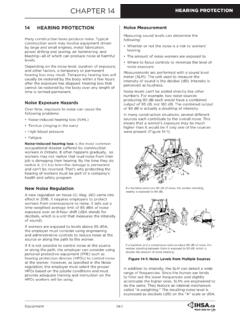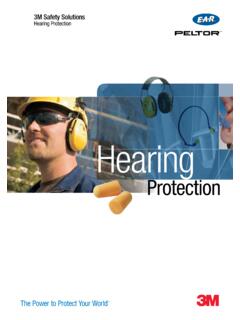Transcription of 1. - CPWR
1 noise and hearing protection 2017, CPWR-The Center for Construction Research and Training. All rights reserved. CPWR is the research and training arm of NABTU. Production of this document was supported by cooperative agreement OH 009762 from the National Institute for Occupational Safety and Health (NIOSH). The contents are solely the responsibility of the authors and do not necessarily represent the official views of NIOSH. On the job, too much noise can distract you. You may not hear warnings. noise damages the nerves in your inner ears. Those nerves cannot be repaired. You might not be able to understand what people are saying. If you are exposed to too much noise , you can lose your hearing and possibly your life. Richard s Story Richard worked on a 16-month road job, jackhammering concrete. The daily noise was so loud that he could not hear the people speak around him.
2 Since the supervisor did not wear hearing protection , Richard did not think he needed to. After the job ended, he began to have ringing in his ears. He had his hearing tested and found that he had a partial hearing loss. Have you or someone you know worked in a high- noise work area without wearing any kind of hearing protection ? Why wasn t hearing protection used? What actions should have been taken to prevent this hearing loss? Remember This Pay attention to noise levels where you work. The best way to know if you need hearing protection is to measure the sound levels (in decibels). If you don't have the tools to do this, the next best way is the shout test. If you have to shout to be heard when standing 3 feet (at arm's length) away from someone, then it's probably over 85 decibels and hearing protection should be worn.
3 Find the most comfortable hearing protectors (earplugs or earmuffs) and make sure you wear them every time you are around loud noise . If you choose to wear disposable foam earplugs, make sure you insert them properly. If you are not sure how to, then ask your supervisor for training. Avoid inserting or removing earplugs if your hands are dirty, to avoid an ear infection. Wear hearing protection and take breaks from loud noise . Look for signs that identify noise hazards. Ask your employer to consider purchasing quieter equipment in the future. If possible, move your work away from noise sources or move the noise sources away from your work area. Have your hearing tested as soon as possible to have a baseline measurement of your hearing . Have it rechecked during regular doctor visits to make sure you haven t damaged your hearing .
4 OSHA Regulation: 1. 2. How can we stay safe today? What will we do at the worksite to reduce noise exposure and protect us from hearing loss? noise and hearing protection 2017, CPWR-The Center for Construction Research and Training. All rights reserved. CPWR is the research and training arm of NABTU. Production of this document was supported by cooperative agreement OH 009762 from the National Institute for Occupational Safety and Health (NIOSH). The contents are solely the responsibility of the authors and do not necessarily represent the official views of NIOSH. Be aware of high- noise areas. Look for signs, measure the noise level, or use the shout test. Wear hearing protection in high- noise areas. If possible, move away from noise -generating equipment or move the equipment away from your work area.
5 Don't spend any more time than necessary around loud noises.



















